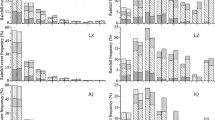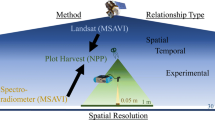Abstract
Methods to detect and quantify shifts in the state of ecosystems are increasingly important as global change drivers push more systems toward thresholds of change. Temporal relationships between precipitation and aboveground net primary production (ANPP) have been studied extensively in arid and semiarid ecosystems, but rarely has spatial variation in these relationships been investigated at a landscape scale, and rarely has such information been viewed as a resource for mapping the distribution of different ecological states. We examined the broad-scale effects of a shift from grassland to shrubland states on spatiotemporal patterns of remotely sensed ANPP proxies in the northern Chihuahuan Desert. We found that the normalized difference vegetation index (NDVI), when averaged across an eight-year period, did not vary significantly between these states, despite changes in ecosystem attributes likely to influence water availability to plants. In contrast, temporal relationships between precipitation and time-integrated NDVI (NDVI-I) modeled on a per-pixel basis were sensitive to spatial variation in shrub canopy cover, a key attribute differentiating ecological states in the region. The slope of the relationship between annual NDVI-I and 2-year cumulative precipitation was negatively related to, and accounted for 71% of variation in, shrub canopy cover estimated at validation sites using high spatial resolution satellite imagery. These results suggest that remote sensing studies of temporal precipitation–NDVI relationships may be useful for deriving shrub canopy cover estimates in the region, as well as for mapping other ecological state changes characterized by shifts in long-term ANPP, plant functional type dominance, or both.






Similar content being viewed by others
References
Archer S, Schimel DS, Holland EA. 1995. Mechanisms of shrubland expansion: land use, climate or CO2? Clim Change 29:91–9.
Ares J, Del Valle H, Bisigato A. 2003. Detection of process-related changes in plant patterns at extended spatial scales during early dryland desertification. Glob Change Biol 9:1643–59.
Bestelmeyer BT, Tugel AJ, Peacock GL, Robinett DG, Shaver PL, Brown JR, Herrick JE, Sanchez H, Havstad KM. 2009. State-and-transition models for heterogeneous landscapes: a strategy for development and application. Rangeland Ecol Manag 62:1–15.
Box EO, Holben BN, Kalb V. 1989. Accuracy of the AVHRR Vegetation Index as a predictor of biomass, primary productivity and net CO2 flux. Vegetatio 80:71–89.
Bradley BA, Mustard JF. 2005. Identifying land cover variability distinct from land cover change: cheatgrass in the Great Basin. Remote Sens Environ 94:204–13.
Chapin FS. 1993. Functional role of growth forms in ecosystem and global processes. In: Ehleringer JR, Field CB, Eds. Scaling physiological processes: leaf to globe. San Diego: Academic Press Inc. p 287–312.
DigitalGlobe. 2006. Quickbird scenes, Level Standard 2A. Longmont, CO: DigitalGlobe.
D’Odorico P, Fuentes JD, Pockman WT, Collins SL, He Y, Medeiros JS, DeWekker S, Litvak ME. 2010. Positive feedback between microclimate and shrub encroachment in the northern Chihuahuan desert. Ecosphere 1(6):art17. doi:10.1890/ES10-00073.1.
Duniway MC, Snyder KA, Herrick JE. 2010. Spatial and temporal patterns of water availability in a grass–shrub ecotone and implications for grassland recovery in arid environments. Ecohydrology 3:55–67.
Ehleringer JR, Phillips SL, Schuster WSF, Sandquist DR. 1991. Differential utilization of summer rains by desert plants. Oecologia 88:430–4.
Eldridge DJ, Whitford WG, Duval BD. 2009. Animal disturbances promote shrub maintenance in a desertified grassland. J Ecol 97:1302–10.
Esri. 2010. ArcGIS 10 Help. Redlands, CA: Esri.
Fabricante I, Oesterheld M, Paruelo JM. 2009. Annual and seasonal variation of NDVI explained by current and previous precipitation across Northern Patagonia. J Arid Environ 73:745–53.
Firn J, House APN, Buckley YM. 2010. Alternative states models provide an effective framework for invasive species control and restoration of native communities. J Appl Ecol 47:96–105.
Gibbens RP, Lenz JM. 2001. Root systems of some Chihuahuan Desert plants. J Arid Environ 49:221–63.
Gibbens RP, McNeely RP, Havstad KM, Beck RF, Nolen B. 2005. Vegetation changes in the Jornada Basin from 1858 to 1998. J Arid Environ 61:651–68.
Gile LH, Gibbens RP, Lenz JM. 1997. The near-ubiquitous pedogenic world of mesquite roots in an arid basin floor. J Arid Environ 35:39–58.
Grime JP. 1977. Evidence for the existence of three primary strategies in plants and its relevance to ecological and evolutionary theory. Am Nat 111:1169–94.
Havstad KM, Schlesinger WH. 2006. Introduction. In: Havstad KM, Huenneke LF, Schlesinger WH, Eds. Structure and function of a Chihuahuan Desert ecosystem: the Jornada Basin Long-term Ecological Research Site. Oxford: Oxford University Press. p 1–18.
Holm AM, Cridland SW, Roderick ML. 2003. The use of time-integrated NOAA NDVI data and rainfall to assess landscape degradation in the arid shrubland of Western Australia. Remote Sens Environ 85:145–58.
House JI, Archer S, Breshears DD, Scholes RJ, NCEAS Tree-Grass Interactions Participants. 2003. Conundrums in mixed woody-herbaceous plant systems. J Biogeogr 30:1763–77.
Huenneke LF, Anderson JP, Remmenga M, Schlesinger WH. 2002. Desertification alters patterns of aboveground net primary production in Chihuahuan ecosystems. Glob Change Biol 8:247–64.
Huenneke LF, Clason D, Muldavin E. 2001. Spatial heterogeneity in Chihuahuan Desert vegetation: implications for sampling methods in semi-arid ecosystems. J Arid Environ 47:257–70.
Huenneke LF, Schlesinger WH. 2006. Patterns of net primary production in Chihuahuan desert ecosystems. In: Havstad KM, Huenneke LF, Schlesinger WH, Eds. Structure and function of a Chihuahuan Desert ecosystem: the Jornada Basin Long-term Ecological Research Site. Oxford: Oxford University Press. p 232–46.
Huete A, Didan K, Miura T, Rodriguez EP, Gao X, Ferreira LG. 2002. Overview of the radiometric and biophysical performance of the MODIS vegetation indices. Remote Sens Environ 83:195–213.
Huete AR, Jackson RD. 1987. Suitability of spectral indices for evaluating vegetation characteristics on arid rangelands. Remote Sens Environ 23:213–32.
Huete AR, Jackson RD, Post DF. 1985. Spectral response of a plant canopy with different soil backgrounds. Remote Sens Environ 17:37–53.
Huxman TE, Smith MD, Fay PA, Knapp AK, Shaw MR, Loik ME, Smith SD, Tissue DT, Zak JC, Weltzin JF, Pockman WT, Sala OE, Haddad BM, Harte J, Koch GW, Schwinning S, Small EE, Williams DG. 2004. Convergence across biomes to a common rain-use efficiency. Nature 429:651–4.
Kéfi S, Rietkerk M, Alados CL, Pueyo Y, Papanastasis VP, ElAich A, de Ruiter PC. 2007. Spatial vegetation patterns and imminent desertification in Mediterranean arid ecosystems. Nature 449:213–17.
Knapp PA. 1996. Cheatgrass (Bromus tectorum L.) dominance in the Great Basin Desert: history, persistence, and influences to human activities. Glob Environ Change 6:37–52.
Krogh SN, Zeisset MS, Jackson E, Whitford WG. 2002. Presence/absence of a keystone species as an indicator of rangeland health. J Arid Environ 50:513–19.
Le Houérou HN, Bingham RL, Skerbek W. 1988. Relationship between the variability of primary production and the variability of annual precipitation in world arid lands. J Arid Environ 15:1–18.
Li J, Okin GS, Alvarez L, Epstein H. 2007. Quantitative effects of vegetation cover on wind erosion and soil nutrient loss in a desert grassland of southern New Mexico, USA. Biogeochemistry 85:317–32.
Monteith JL. 1972. Solar radiation and productivity in tropical ecosystems. J Appl Ecol 9:747–66.
Muldavin EH, Moore DI, Collins SL, Wetherill KR, Lightfoot DC. 2008. Aboveground net primary production dynamics in a northern Chihuahuan Desert ecosystem. Oecologia 155:123–32.
Neave M, Abrahams AD. 2002. Vegetation influences on water yields from grassland and shrubland ecosystems in the Chihuahuan Desert. Earth Surf Proc Land 27:1011–20.
Neilson RP. 1986. High-resolution climatic analysis and southwest biogeography. Science 232:27–34.
Nicholson SE, Tucker CJ, Ba MB. 1998. Desertification, drought and surface vegetation: an example from the West African Sahel. Bull Am Meteorol Soc 79:815–29.
Oesterheld M, Loreti J, Semmartin M, Sala OE. 2001. Inter-annual variation in primary production of a semi-arid grassland related to previous-year production. J Veget Sci 12:137–42.
Omuto CT, Vargas RR, Alim MS, Paron P. 2010. Mixed-effects modelling of time series NDVI-rainfall relationship for detecting human-induced loss of vegetation cover in drylands. J Arid Environ 74:1552–63.
Paruelo JM, Epstein HE, Lauenroth WK, Burke IC. 1997. ANPP estimates from NDVI for the central grassland region of the United States. Ecology 78:953–8.
Paruelo JM, Oesterheld M, Di Bella CM, Arzadum M, Lafontaine J, Cahuepé M, Rebella CM. 2000. Estimation of primary production of subhumid rangelands from remote sensing data. Appl Veget Sci 3:189–95.
Paulsen HA, Ares FN. 1962. Grazing values and management of black grama and tobosa grasslands and associated shrub ranges of the southwest. USDA Technical Bulletin 1270.
Peters DPC, Yao J, Sala OE, Anderson J. 2011. Directional climate change and potential reversal of desertification in arid and semiarid ecosystems. Glob Change Biol. doi:10.1111/j.1365-2486.2011.02498.x.
Pineiro G, Oesterheld M, Paruelo JM. 2006. Seasonal variation in aboveground production and radiation-use efficiency of temperate rangelands estimated through remote sensing. Ecosystems 9:357–73.
Prince SD. 1991. Satellite remote sensing of primary production: comparison of results for Sahelian grasslands 1981–1988. Int J Remote Sens 12:1301–11.
Prince SD, Brown de Colstoun E, Kravitz LL. 1998. Evidence from rain-use efficiencies does not indicate extensive Sahelian desertification. Glob Change Biol 4:359–74.
Reynolds JF, Virginia RA, Kemp PR, De Soyza AG, Tremmel DC. 1999. Impact of drought on desert shrubs: effects of seasonality and degree of resource island development. Ecol Monogr 69:69–106.
Running SW, Nemani RR, Heinsch FA, Zhao M, Reeves M, Hashimoto H. 2004. A continuous satellite-derived measure of global terrestrial primary production. Bioscience 54:547–60.
SAS Institute. 2008. The SAS system for Windows 9.2. Cary, NC: SAS Institute Inc.
Schlesinger WH, Reynolds JF, Cunningham GL, Huenneke LF, Jarrell WM, Virginia RA, Whitford WG. 1990. Biological feedbacks in global desertification. Science 247:1043–8.
Schwinning S, Ehleringer JR. 2001. Water use trade-offs and optimal adaptations to pulse-driven arid ecosystems. J Ecol 89:464–80.
Sellers PJ, Berry JA, Collatz GJ, Field CB, Hall FG. 1992. Canopy reflectance, photosynthesis, and transpiration. III. A reanalysis using improved leaf models and a new canopy integration scheme. Remote Sens Environ 42:187–216.
Smoliak S. 1986. Influence of climatic conditions on production of Stipa–Bouteloua prairie over a 50-year period. J Range Manag 39:100–3.
Standish RJ, Cramer VA, Wild SL, Hobbs RJ. 2007. Seed dispersal and recruitment limitation are barriers to native recolonisation of old-fields in western Australia. J Appl Ecol 44:435–45.
Turnbull L, Wainwright J, Brazier RE. 2010. Changes in hydrology and erosion over a transition from grassland to shrubland. Hydrol Process 24:393–414.
Van Auken OW. 2000. Shrub invasions of North American semiarid grasslands. Annu Rev Ecol Syst 31:197–215.
Verón SR, Oesterheld M, Paruelo JM. 2005. Production as a function of resource availability: slopes and efficiencies are different. J Veget Sci 16:351–4.
Verón SR, Paruelo JM. 2010. Desertification alters the response of vegetation to changes in precipitation. J Appl Ecol 47:1233–41.
Verón SR, Paruelo JM, Oesterheld M. 2006. Assessing desertification. J Arid Environ 66:751–63.
Wallace CSA, Thomas KA. 2008. An annual plant growth proxy in the Mojave Desert using MODIS-EVI data. Sensors 8:7792–808.
Wessels KJ, Prince SD, Malherbe J, Small J, Frost PE, VanZyl D. 2007. Can human-induced land degradation be distinguished from the effects of rainfall variability? A case study in South Africa. J Arid Environ 68:271–97.
Yahdjian L, Sala OE. 2006. Vegetation structure constrains primary production response to water availability in the Patagonian steppe. Ecology 87:952–62.
Acknowledgments
We would like to thank José Paruelo and two anonymous reviewers for helpful comments on this manuscript. This study was funded by the USDA Rangeland Research Program (2007-38415-18637) and the USDA-NRI Biology of Weedy and Invasive Species program (2008-35320-18684). Funding support was also provided by the National Science Foundation to New Mexico State University as part of the Jornada Basin Long Term Ecological Research Program (DEB-0618210).
Author information
Authors and Affiliations
Corresponding author
Additional information
Author Contributions
Jeb C. Williamson: study design, data collection, preparation, analysis, and interpretation, and principal author; Brandon T. Bestelmeyer: study conception and design, data interpretation, and contributing author; Debra P. C. Peters: data preparation, interpretation, and contributing author.
Rights and permissions
About this article
Cite this article
Williamson, J.C., Bestelmeyer, B.T. & Peters, D.P.C. Spatiotemporal Patterns of Production Can Be Used to Detect State Change Across an Arid Landscape. Ecosystems 15, 34–47 (2012). https://doi.org/10.1007/s10021-011-9490-2
Received:
Accepted:
Published:
Issue Date:
DOI: https://doi.org/10.1007/s10021-011-9490-2




